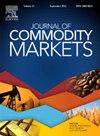Portfolio implications based on quantile connectedness among cryptocurrency, stock, energy, and safe-haven assets
IF 4.5
4区 经济学
Q1 BUSINESS, FINANCE
引用次数: 0
Abstract
We employ a quantile time-frequency connectedness model to investigate the interdependencies among four asset groups: cryptocurrencies (Bitcoin, Ethereum, and BNB), stocks (S&P 500, Euro Stoxx 50, FTSE 100, and Nikkei 225), safe-haven assets (gold, the US dollar, and treasury bills), and energy markets (oil, gas, coal, and electricity), using daily data from November 2017 to November 2024 (1625 observations). Our results reveal that, under normal market conditions, markets are more affected by their own shocks than by cross-market spillovers. This indicates that investors should pay closer attention to endogenous risks during stable periods. Moreover, we find that diversification across different asset classes is more effective under normal conditions, while investing within the same group may be more appropriate during bullish or bearish market phases. Market uncertainty also tends to rise as conditions become more extreme. This study is the first to confirm quantile-based connectedness both within and across asset classes in the time-frequency domain. Our findings contribute to a deeper understanding of market interactions and offer practical insights for investment decisions, portfolio management, and regulatory policy in an increasingly interconnected global financial environment.
基于加密货币、股票、能源和避险资产之间分位数连通性的投资组合影响
我们采用分位数时频连通性模型来调查四个资产组之间的相互依赖性:加密货币(比特币、以太坊和BNB)、股票(标准普尔500指数、欧洲斯托克50指数、富时100指数和日经225指数)、避险资产(黄金、美元和国库券)和能源市场(石油、天然气、煤炭和电力),使用的是2017年11月至2024年11月的每日数据(1625次观察)。我们的研究结果表明,在正常的市场条件下,市场受自身冲击的影响大于受跨市场溢出效应的影响。这表明,在稳定时期,投资者应更加关注内生风险。此外,我们发现,在正常情况下,不同资产类别的多元化更有效,而在看涨或看跌市场阶段,在同一组投资可能更合适。随着情况变得更加极端,市场的不确定性也往往会上升。这项研究首次在时频域内确认了资产类别内部和资产类别之间基于分位数的连通性。我们的研究结果有助于加深对市场相互作用的理解,并为日益相互关联的全球金融环境中的投资决策、投资组合管理和监管政策提供实用见解。
本文章由计算机程序翻译,如有差异,请以英文原文为准。
求助全文
约1分钟内获得全文
求助全文
来源期刊

Journal of Commodity Markets
Multiple-
CiteScore
5.70
自引率
2.40%
发文量
53
期刊介绍:
The purpose of the journal is also to stimulate international dialog among academics, industry participants, traders, investors, and policymakers with mutual interests in commodity markets. The mandate for the journal is to present ongoing work within commodity economics and finance. Topics can be related to financialization of commodity markets; pricing, hedging, and risk analysis of commodity derivatives; risk premia in commodity markets; real option analysis for commodity project investment and production; portfolio allocation including commodities; forecasting in commodity markets; corporate finance for commodity-exposed corporations; econometric/statistical analysis of commodity markets; organization of commodity markets; regulation of commodity markets; local and global commodity trading; and commodity supply chains. Commodity markets in this context are energy markets (including renewables), metal markets, mineral markets, agricultural markets, livestock and fish markets, markets for weather derivatives, emission markets, shipping markets, water, and related markets. This interdisciplinary and trans-disciplinary journal will cover all commodity markets and is thus relevant for a broad audience. Commodity markets are not only of academic interest but also highly relevant for many practitioners, including asset managers, industrial managers, investment bankers, risk managers, and also policymakers in governments, central banks, and supranational institutions.
 求助内容:
求助内容: 应助结果提醒方式:
应助结果提醒方式:


